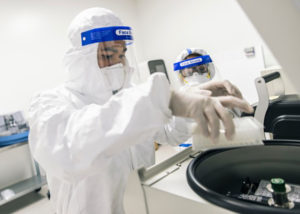
As the latest COVID-19 wave recedes, testing demand will likely follow. [Image courtesy of Amazon]
Moody’s warned investors that supply chain disruptions and healthcare worker shortages will continue to pressure medical product and device companies in 2022.
The good news from the Moody’s Healthcare Quarterly report? The supply chain issues are manageable, with Moody’s estimating that transportation costs average less than 3% of revenue for most large, rated device companies, which won’t eat up too much of those companies’ 20% profit margins.
The bad news: Healthcare labor shortages show no sign of improvement, with nearly a quarter of U.S. hospitals reporting critical staffing shortages in early January due to the omicron COVID-19 variant, according to the U.S. Department of Health and Human Services.
“Large numbers of nurses and other skilled workers will continue to leave the workforce as a result of fatigue, caregiving responsibilities and the opportunity to earn higher wages in other fields. … The shortage is curtailing elective surgeries in hospitals across the country,” Moody’s said in the report. “If the healthcare system globally remains capacity constrained, it would have a material impact on procedure volumes, and therefore, some medical product and device companies.”
More good news: The omicron wave seems to be receding, and hospital capacity could open back up just as it did after the delta wave, relieving the burden on healthcare workers and bringing in patients who delayed elective procedures.
“Volumes and industry revenues had largely returned prior to Omicron, and in some cases exceeded pre-pandemic levels. We expect industry revenues to further expand in 2022, driven by pent-up demand for deferred procedures,” the report said.
Because we’ve been through this before, we know there’s a big “but” coming: “However, there is a meaningful downside risk to our view if the current, or a future, variant remains widespread,” Moody’s said in the report.
Edwards Lifesciences, Zimmer Biomet, Cardiovascular Systems and Boston scientific are among the companies that have recently cited continued sales impacts from the omicron variant and/or associated labor shortages.
If ever-increasing vaccination rates are able to push down cases and the spread of new variants, COVID-19 testing revenue for diagnostics firms like Abbott and Hologic will also likely decrease.
The upside for those companies is that acceptance of at-home testing seems to be increasing and “such tests, whether for the coronavirus or other types of diseases, like the flu, will likely become a more permanent feature of the healthcare landscape,” the report said.
What does all this mean for mergers and acquisitions? Moody’s expects activity “will remain robust in 2022 as most medical device companies have seen their credit metrics largely recover since the onset of the pandemic.”
Most of the transactions will be valued at or below $1 billion as they have historically, and Moody’s expects fewer mega-deals like Baxter’s $12.5 billion purchase of Hill-Rom Holdings.
Moody’s cited Becton, Dickinson and Co.’s appetite for moderately priced tuck-in deals and said “acquirers will mostly look to buy companies that support or enhance their key product franchises.”
That’s what Medtronic CFO Kathleen Parkhill said when she discussed the M&A strategy of medtech’s largest player with Medical Design & Outsourcing in the second half of last year.